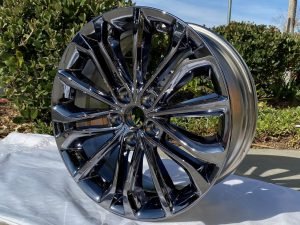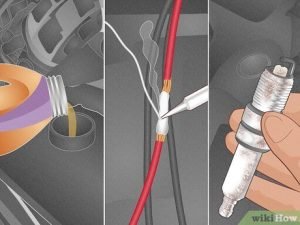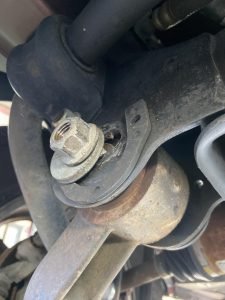To calculate MPG with bigger tires, divide the distance traveled by the number of gallons of fuel used. When you install larger tires on your vehicle, it effectively changes the gear ratio and affects your speedometer reading.
This alteration can impact your vehicle’s calculated miles per gallon (MPG). Therefore, to accurately calculate MPG with bigger tires, it is necessary to adjust for the difference in tire size by using the corrected miles traveled. By following this approach, you can ensure a more precise calculation of your vehicle’s fuel efficiency.
Contents
- How Bigger Tires Affect Mpg
- Understanding The Effects Of Bigger Tires On Mpg
- Factors To Consider When Calculating Mpg With Bigger Tires
- The Calculation Process For Mpg With Bigger Tires
- Step 1: Collecting The Necessary Data
- Step 2: Understanding Gear Ratio And Rpm
- Step 3: Calculating The New Effective Gear Ratio
- Step 4: Adjusting Odometer Readings
- Step 5: Monitoring Fuel Consumption And Calculating Mpg
- Tips For Optimizing Fuel Efficiency With Bigger Tires
- Conclusion: Making Informed Decisions For Fuel Efficiency With Bigger Tires
- Frequently Asked Questions For How To Calculate Mpg With Bigger Tires
- Conclusion
How Bigger Tires Affect Mpg
When it comes to calculating MPG with bigger tires, understanding the impact on fuel efficiency is crucial. Bigger tires can affect your vehicle’s MPG, causing it to decrease. It is important to consider factors such as increased rolling resistance and changes in overall gear ratio.
To calculate MPG accurately with bigger tires, you need to gather data on the tire’s size, the vehicle’s odometer reading, and the amount of fuel consumed. By dividing the number of miles traveled by the amount of fuel used, you can determine the new MPG.
Keep in mind that larger tires may result in a lower MPG, so it’s essential to adjust your driving habits accordingly. Monitoring your MPG regularly will help you optimize fuel efficiency and make informed decisions about tire upgrades.
Understanding The Effects Of Bigger Tires On Mpg
Understanding the effects of bigger tires on MPG requires considering the tire size’s impact on the overall gear ratio and revolutions per mile. When opting for larger tires, the gear ratio is affected, leading to a change in the number of revolutions made by the tire for each mile traveled.
This alteration in rotations impacts the fuel consumption of a vehicle. Bigger tires result in fewer rotations, which can positively influence fuel efficiency by reducing the engine’s workload. However, it’s important to note that other factors, such as vehicle weight, driving habits, and road conditions, also play a significant role in determining MPG.
Careful consideration of these elements is necessary when calculating the MPG impact of bigger tires.
Factors To Consider When Calculating Mpg With Bigger Tires
Calculating MPG with bigger tires involves considering a few factors. One significant factor is the impact on speedometer accuracy. When you change the tire size, the speedometer may no longer provide accurate readings. The difference in tire circumference needs to be adjusted for to ensure the odometer readings remain reliable.
This adjustment is necessary because the larger tires cover more ground with each revolution, leading to a potential discrepancy in the distance traveled. By taking into account these factors and making the necessary calculations, you can determine the accurate MPG with bigger tires.
Remember to consider the specific measurements of the tires and consult with experts if needed to ensure you have accurate calculations. This will help you make informed decisions regarding fuel consumption and efficiency.
The Calculation Process For Mpg With Bigger Tires
Calculating MPG with bigger tires involves determining the new effective gear ratio and measuring actual fuel consumption. The process requires accurate calculations to ensure precise results. By understanding the impact of larger tires on the gear ratio, you can calculate the new MPG effectively.
Measuring fuel consumption allows you to determine the exact amount of fuel used and calculate MPG accurately. With this information, you can make informed decisions when it comes to optimizing your vehicle’s performance and fuel efficiency. Understanding the calculation process is essential for drivers who have upgraded their tires to larger sizes and want to track their MPG to ensure optimal performance.
With the right calculations and measurements, you can calculate your vehicle’s MPG with bigger tires easily and accurately.
Step 1: Collecting The Necessary Data
Calculating mpg (miles per gallon) with bigger tires requires collecting necessary data. First, record your vehicle’s current tire size and performance. Then, gather details about the new, larger tires you plan to install. By comparing the two sets of information, you can determine the impact on your vehicle’s fuel efficiency.
It is important to consider factors such as the overall diameter, width, and revolutions per mile of the new tires. These figures can be obtained from the tire manufacturer’s specifications or using an online tire size calculator. With the data in hand, you can make an accurate calculation of the new fuel economy using available online mileage calculators or performing a manual calculation using the formula: New MPG = (Old MPG x Old tire revolutions per mile) / New tire revolutions per mile.
Step 2: Understanding Gear Ratio And Rpm
Understanding how gear ratio and engine RPM are related to fuel consumption is crucial when calculating MPG with bigger tires. With larger tires, the gear ratio changes, affecting the RPM at which the engine operates. Higher RPM can result in increased fuel consumption, as the engine works harder to maintain speed.
Conversely, lower RPM can lead to lower fuel consumption, as the engine operates at a more efficient level. It’s important to consider the impact of larger tires on gear ratio and RPM when calculating MPG, as this can provide insight into how the vehicle’s fuel efficiency may change.
By carefully analyzing the relationship between gear ratio, RPM, and fuel consumption, you can accurately calculate MPG with bigger tires and make informed decisions about your vehicle’s performance.
Step 3: Calculating The New Effective Gear Ratio
Calculating the new effective gear ratio when you have bigger tires involves using the tire diameter and axle ratio. By determining the updated gear ratio, you can accurately calculate MPG (miles per gallon). Here, we will provide case study examples that demonstrate the calculation process.
With the right understanding of how these factors interact, you can ensure your vehicle’s fuel efficiency remains optimal even with larger tires. By considering the tire diameter and axle ratio, you can adjust the gear ratio to compensate for the changes caused by the bigger tires.
This calculation is crucial for accurately determining MPG and optimizing your vehicle’s performance.
Step 4: Adjusting Odometer Readings
Adjusting odometer readings is an essential step when calculating MPG with bigger tires. The correlation between tire circumference and odometer accuracy is critical to understand. When you increase the size of your tires, the distance measurements may become inaccurate. To compensate for this difference, you need to adjust the odometer readings accordingly.
This ensures that your MPG calculations remain precise. By accounting for the change in tire size, you can accurately determine your vehicle’s fuel efficiency. It’s important to note that failing to adjust the odometer readings can lead to inaccurate MPG calculations and potentially affect other aspects of your vehicle’s performance.
Therefore, take the time to understand how your tire size impacts the odometer and make the necessary adjustments for accurate measurements.
Step 5: Monitoring Fuel Consumption And Calculating Mpg
Tracking fuel usage over a specific distance and time, you can accurately calculate MPG. By monitoring fuel consumption and gathering data, you can determine the efficiency of your vehicle. With bigger tires, it’s important to keep an eye on fuel efficiency as it can impact MPG.
By recording the amount of fuel used and the distance traveled, you can calculate the miles per gallon. This information allows you to make informed decisions about your vehicle’s performance and potential areas for improvement. Regularly tracking your fuel consumption and calculating MPG helps you understand the impact of factors like tire size on your vehicle’s efficiency.
With this knowledge, you can optimize your driving habits and make adjustments as necessary to maximize fuel economy.

Credit: www.morriesokemosford.com
Tips For Optimizing Fuel Efficiency With Bigger Tires
Driving with larger tires can affect your vehicle’s fuel efficiency. To calculate your MPG with bigger tires, there are a few tips to optimize fuel efficiency. First, make sure to adjust your speedometer to account for the change in tire size.
This can be done with a speedometer recalibration tool or by taking your vehicle to a mechanic. Additionally, consider upgrading to low rolling resistance tires, which can further improve your MPG. Regular tire maintenance is also crucial, such as ensuring proper tire inflation and alignment.
Lastly, practicing efficient driving habits like smooth acceleration and avoiding unnecessary idling can help maximize your MPG. By following these measures, you can enhance your fuel efficiency when using larger tires.
Conclusion: Making Informed Decisions For Fuel Efficiency With Bigger Tires
Larger tires can have a significant impact on your vehicle’s fuel efficiency. Understanding the relationship between tire size and MPG is crucial for making informed decisions. By empowering drivers to calculate and optimize their vehicle’s fuel efficiency with bigger tires, they can save money and reduce their carbon footprint.
When using larger tires, it is important to consider a few factors, such as the overall dimensions, weight, and rolling resistance. These factors affect how the vehicle consumes fuel and ultimately determines its MPG. By carefully analyzing these variables, drivers can make smart choices that result in improved fuel efficiency.
Whether it’s for economic or environmental reasons, calculating MPG with larger tires is an essential skill for any driver. So, make sure to do your research and make informed decisions to maximize your vehicle’s fuel efficiency.
Frequently Asked Questions For How To Calculate Mpg With Bigger Tires
How Much Mpg Will I Lose With Bigger Tires?
Bigger tires can cause a decrease in MPG.
How Do You Calculate Fuel Economy With Bigger Tires?
To calculate fuel economy with bigger tires, divide the distance traveled by the amount of fuel consumed.
Do Bigger Tires Increase Mpg?
No, bigger tires do not increase mpg.
What Is The Formula For Calculating Mpg?
The formula for calculating mpg is dividing the total miles traveled by the amount of gas used.
Conclusion
Calculating MPG with bigger tires is a process that requires attention to detail and a few extra steps compared to calculating MPG with standard sized tires. By taking into account the actual tire size, odometer reading, and fuel consumption, you can accurately determine your vehicle’s MPG.
The key takeaway is to adjust the odometer reading and fuel consumption to account for the changes in circumference and revolutions of the tires. It’s worth noting that while bigger tires may improve off-road performance and aesthetic appeal, they can negatively impact fuel efficiency due to increased rolling resistance.
However, with proper calculations and taking proactive steps to mitigate the effects of bigger tires on MPG, you can enjoy the benefits without significantly sacrificing fuel economy. Keep in mind that these calculations are estimates, and it’s always a good idea to monitor your fuel consumption regularly to ensure optimal performance and efficiency.
Happy driving!
Affiliate Disclosure: As an Amazon Associate, I earn from qualifying purchases made through links on this site.








